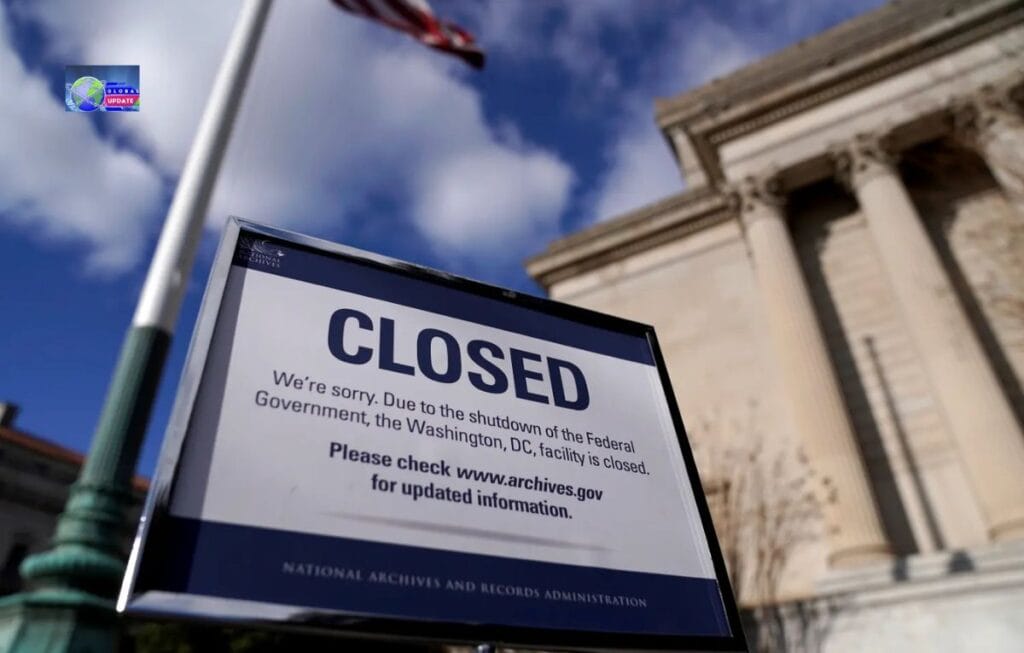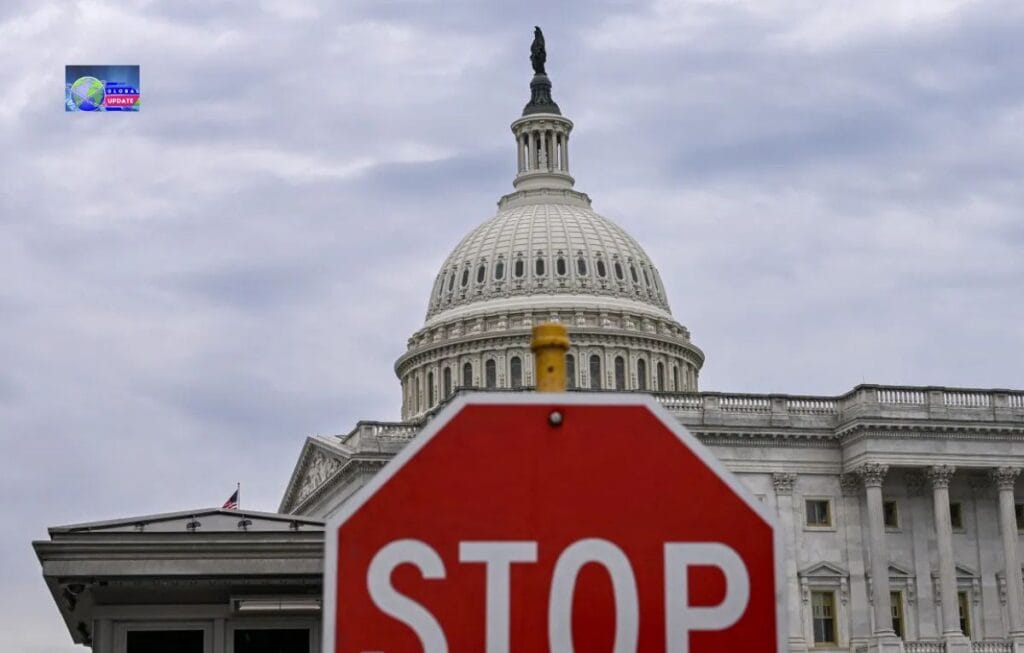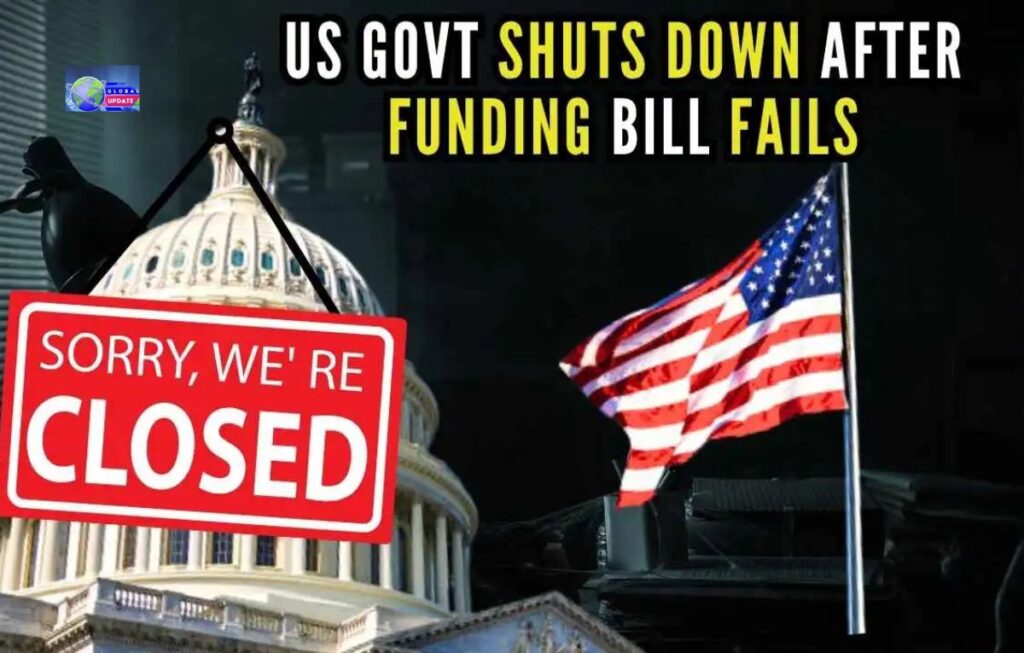The historic U.S. shutdown continues to cripple federal operations as Congress remains divided over funding for healthcare subsidies.
The shutdown began on October 1, 2025, after lawmakers failed to pass appropriations bills due to a fierce political dispute between Republicans, who oppose the continuation of Affordable Care Act (ACA) subsidies, and Democrats, who insist those healthcare supports must remain.
The crisis has furloughed hundreds of thousands of federal employees, frozen paychecks, and caused significant disruption across public services, from food assistance programs like SNAP to airport safety operations.
Economists estimate the closure has already cost the U.S. economy up to $14 billion, while consumer confidence has dropped to its lowest level in nearly five decades.

Background & Trigger
On October 1, 2025, the federal government of the United States entered a shutdown after Congress failed to pass appropriations legislation to fund agencies for Fiscal Year 2026.
The shutdown began when the previous continuing resolution expired and no new funding measure was approved.
The central political impasse: Republicans (who control the House) pushed a funding bill that did not extend key health insurance subsidies under the Affordable Care Act (ACA).
At the same time, Senate Democrats refused to pass funding bills without those subsidies included.
Thus, the shutdown reflects both a budgetary stalemate and a deeper policy fight (healthcare subsidies and spending priorities).
Milestones & Developments
- By early November, the historic U.S. shutdown had become the longest in U.S. history, surpassing the previous record of 35 days (from 2019) under the Trump administration.
- On November 9–10, the United States Senate voted to advance a funding bill that would reopen government by funding agencies through January 30, 2026, and include three full-year appropriation bills.
- The Senate vote was 60-40 in favour of advancing the bill, including eight Democrats crossing party lines to join Republicans.
- Nevertheless, disagreements still exist because the package does not contain the ACA subsidy extension that Democrats had requested. A separate vote on that matter has been scheduled for December.
- The agreement includes several important operational elements, such as a ban on additional federal employee terminations until January 2026, back pay for furloughed workers, and full-year funding for certain departments (including Agriculture and Veterans Affairs) instead of just stopgap funding.
Impacts & Consequences
Economic
The economic costs are mounting. The nonpartisan Congressional Budget Office (CBO) estimated that the shutdown could cost the U.S. economy between US$7 billion and US$14 billion in lost output, with a potential 2% drag on GDP in Q4 2025.
Another White House memo warned of up to US$15 billion of GDP loss each week the shutdown continues, plus thousands more unemployed.
Consumer confidence has also dropped sharply: according to the University of Michigan’s survey, the index fell to 50.3 in November (from 53.6 in October), the lowest since 1978.

Federal Employees & Government Services
Hundreds of thousands of federal employees have been furloughed (sent home without pay), and many more designated “essential” have been required to work without pay.
The deal under negotiation includes retroactive pay for those who have been working without pay.
Many services have disrupted:
- The Supplemental Nutrition Assistance Program (SNAP) benefits for November were at risk because regular funding lapsed, prompting mayors and states to urge the United States Department of Agriculture (USDA) to use contingency funds.
- Courts, public health programs, air-travel oversight, and other agencies are strained or partially shut down. For example, staffing issues in air traffic control have led to flight cancellations and delays, as noted in recent coverage.
Political & Social
Politically, the shutdown presents risks for the Republican majority controlling the House and the White House, as public polling increasingly places blame on Republicans.
For Democrats, the strategy of resisting funding without healthcare subsidy concessions has energized some parts of their base, though internal divisions are evident (not all Democrats supported the Senate advance).
Socially, the shutdown is having a real impact on American families and local communities: rising food insecurity, delayed benefits, and economic anxiety are mounting. The consumer-sentiment drop, food-aid delays, and broad anxiety reflect that.
Current Status (as of 10 Nov 2025) & Outlook
- The Senate’s advancement of the funding measure is a key breakthrough, suggesting the shutdown may end soon.
- But hurdles remain: the bill must still passed by the House and then signed by President Donald Trump (or overridden in the event of a veto). Timing is unclear and could take days.
- The unresolved healthcare subsidy issue is a significant sticking point: Democrats insist that any reopening must include extension of ACA subsidies; Republicans are keen to separate the subsidies issue from reopening the government.
- If the historic U.S. shutdown ends soon, some of the economic damage may mitigated. However, if it drags on further (into late November or beyond), losses will grow significantly. The CBO and other bodies warn of increasing permanent output loss.

Implications for Americans & Beyond
- Federal workers & government contractors: Many have missed paychecks or continue to work without compensation. Back pay may included in the deal, but the stress and disrupted personal finances are real.
- Low-income households: With SNAP and other assistance programs at risk, millions are vulnerable. Delays or reductions in benefits increase hardship.
- Broader economy: Consumer spending, business confidence, hiring decisions, and even private-sector job growth may affected by this uncertainty. The sentiment drop is a red flag.
- Travel & infrastructure: Air travel is already seeing cancellations and staffing issues; disruptions may worsen during the upcoming holiday season.
- Policy precedent: The historic U.S. shutdown exposes the fragility of U.S. budget processes and the potential for partisan policy fights to shut down large parts of government. The handling of ACA subsidies may set a precedent regarding how healthcare policy interacts with budget fights.
- International perception: A prolonged U.S. government shutdown has implications for global markets, economic stability, the reliability of U.S. government agencies, and confidence in U.S. economic leadership.
Conclusion
Due to its duration, the range of its effects, and the policy stakes, the 2025 U.S. federal government shutdown is unprecedented.
Even while the Senate has made great progress in restoring government, there are still many procedural and political obstacles to overcome.
There is a significant deal of urgency because the longer the shutdown lasts, the more it will hurt vulnerable residents, federal employees, and the American economy.
For ordinary Americans, the shutdown is not just a headline—it is a disruption to services, paychecks, and financial stability.
In short, things may turning toward a resolution, but the deal is done.
The next few days will critical for determining how quickly the government reopens. How many concessions made (especially on healthcare subsidies), and how deep the long-term damage will be.



